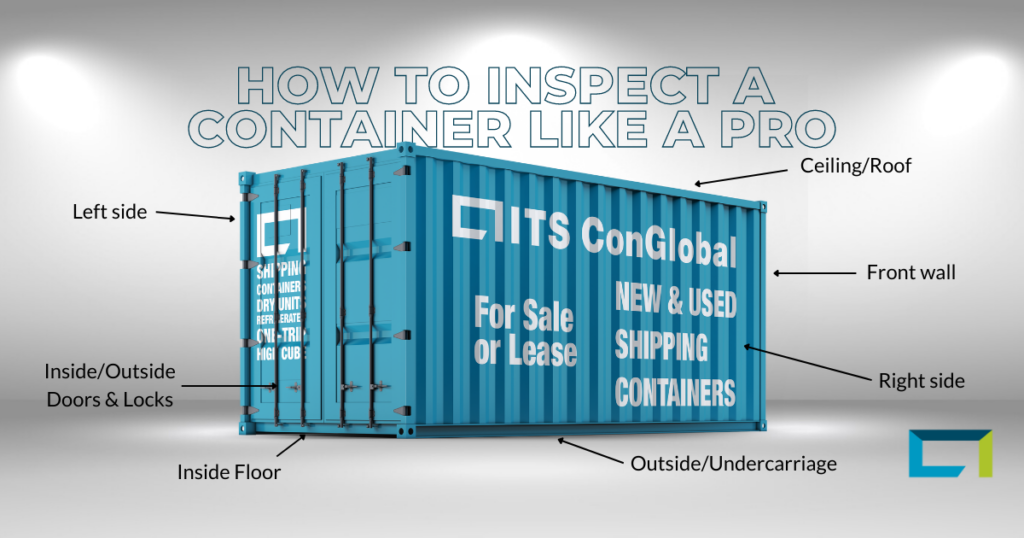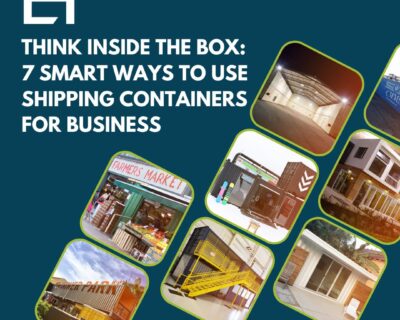News
How to Inspect a Container Like a Pro

The mighty shipping container. Designed for rough crossings and handling. Their job is simple: protecting goods from theft and damage during storage or shipping. Because containers are used and reused, they will experience some wear and tear. Some wear won’t impact the security of goods, but damage can cause frustration if they leak or if they are rejected by shipping lines for unfitness. Don’t get caught with a sub-par container. Be a savvy consumer and protect your investment and cargo by learning how to inspect a shipping container like a pro.
Don’t feel ready to go it alone? ITS ConGlobal is your go-to expert in container sales. Connect with our top-notch sales team who will assist you every step of the way.
A brief history of shipping containers
Most of us don’t give the humble shipping container much thought. But this simple invention revolutionized shipping and global trade.
Before shipping containers were invented, goods were loaded into sacks, barrels, wooden crates, or simply wrapped in sheets. This method is known as break-bulk shipping. The work was labor-intensive, expensive, and slow. It could take up to 3 weeks to unload and load each ship.
In 1952 American road-hauler and entrepreneur Malcolm McLean saw an opportunity to cut costs and speed up the movement of goods. He imagined lifting his trailers onto ships without touching the contents. McLean sold his trucking company in 1956 and purchased the Pan Atlantic Tanker Company soon after.
Fueled by perseverance, McLean quickly started converting a World War II oil tanker into a ship capable of carrying containers. Ideal X made her maiden voyage on April 26, 1956, sailing from New Jersey to Texas carrying 58 metal containers and 15,000 tons of petroleum.
McLean’s ‘big box’ idea was a success. In 1968 the International Standards Organization standardized his invention. Each standardized box measures 20 feet long, 8 feet high, and 8 feet wide.
The anatomy of a container
Before you can inspect a container like a pro, you must understand the basic anatomy of a shipping container.
Modern shipping containers are almost indestructible because of their Corten steel structure. Alloys distinguish Corten steel from other types of steel. It is unique because it is weldable and developed to resist harsh weather and corrosion, making containers nearly indestructible.
The main structural components of a shipping container are:
- The roof—is made of Corten steel sheets with corrugated profiles to give the roof strength and rigidity
- Side walls—are corrugated to provide added strength
- Flooring—consists of 28mm laminated Marine plywood
- Cross members—structural components that make up the floor along with forklift pockets
- Top/bottom rails—the rails form the frame of the container. Top rails can be either box section profiles or 10mm flat bar profiles.
- Corner posts—made of 10mm high-tensile steel
- Doors, fittings, CSC plate—doors open 180 degrees, and fittings like hinge pins, lock rods, locking cams and keepers, door handles, door brackets and lockboxes keep cargo secure. Each unit has a Container Safety Convention or CSC plate on the left-hand door.
China produces more than 90 percent of the sea containers globally. The units are built to last decades when properly stored and maintained. The average service life is 10-12 years in harsh environments like the sea, and afterward, they can be refurbished and repurposed for many other purposes.
Looking for more information? Check out our guide to shipping containers.
The main reasons for container damage
Freightwaves states, “One out of four containers that pass through US ports gets damaged at some interchange points.” Damage usually falls into three major categories human error, weather, natural disasters, or incorrect handling or accidents.
Once you understand the most common types of damage, you will boost your ability to catch sneaky issues like a pro.
How to avoid human error
Avoiding damage starts with selecting the correct container for your intended purpose. People buy steel shipping containers for shipping goods overseas, building and DIY projects, and agricultural and residential storage. Each situation calls for different container capabilities, and how and where you plan to use the container dictates which is the best choice.
Not sure what the best choice is? No problem, our Customer Engagement Center is staffed with expert help—tap to talk now at 800-255-4835. Or, check out our 5-Step Guide to Buying a Shipping container.
Bad stowing is another human error to avoid and can damage our shipping container and ruin your cargo. Overloading the container, unevenly distributing the weight, loosely tying up cargo, or insufficient use of dunnage can cause cargo to sway during transport. Bad stowing damages freight by creating excess moisture, contamination, infestation, or reefer-related damage.
Understanding how the weather impacts shipping containers
When cargo is transported through international supply routes, shipping containers experience extreme temperature shifts that can lead to damaged goods.
Weather is unpredictable and can cause internal and external damage to shipping containers. The moisture-filled ocean air can get trapped in the container, settling in the colder areas. When the container moves to a hotter region, the moisture condenses into water and climbs on the walls and ceiling. Then the water drips down, causing container rain or container sweat. This condition results in rusting and corrosion of the container walls.
Because of their rugged steel structure, shipping containers can withstand extreme weather conditions like snow and freezing temperatures, wildfires, heavy rains, and even tornados. While the steel is corrosion-resistant, it is not rustproof.
How containers are damaged through handling or accidents
Container damages happen while the unit is loaded or unloaded. Inexperienced operators can cause punctures or dents, stack them unevenly, or drop containers. Depending on the damage severity and proactive repairs, the container may continue in-service.
Over the years, we’ve seen many types of damage, but the most common are:
- Broken container doors—can happen to bad handling, careless security of the doors, road accidents, or being pried open by thieves.
- Dents, scratches, or holes—repeated handling can cause blemishes on boxes, but more extensive damage can happen because of poor handling, scraping against other containers, or road accidents.
- Dropped container—overloaded containers behave unexpectedly, and handling can be complex.
- Road accidents or train derailments—are unexpected events that exceed speed limits, bad weather, road or rail conditions, and driver fatigue.
- Heat damage—condensation is known as container rain, or sweat can ruin cargo and degrade the container itself. But incorrectly storing or segregating goods can also cause fire hazards.
How to inspect a container like a pro
Now that you understand the history, anatomy, and how containers end up damaged, let’s talk about how to inspect a shipping container like a pro.
Take a look at the outside of the container:
- Check the corners and seams. You can expect to see some wear or minor damage. But the damage to the welded connections is not ok. Pro tip: watch for warping, rust, corrosion, and cracks. This signals structural integrity issues.
- Read the CSC plate. The external plate will spell the manufacturer’s name and origin date. Many shipping containers include their maintenance history. Before use, you will want to remove any previously added placards or markings.
- Check out the doors and locks. Swing the doors open and shut. Make sure the door closes tightly, and the locks are undamaged.
- Inspect the roof. Look for damage, cracks, deep dents, and corrosion. These can weaken the integrity of the unit.
- Pay special attention to any blemishes on the surface. Expect to see minimal surface scratches and dents. Pro tip: pay extra attention to areas that have structural rust.
Look inside the container:
- Look for cracks and leaks. Pro tip: step inside the container and close the door. Look for light peeking through the cracks. If you see it, the container is not watertight.
- Make sure it’s dry, clean, and odorless. Pro tip: Confirm that no chemicals, stains, or corrosives are left inside.
- Inspect for protrusions. If you plan to ship or store goods in your shipping container, look for nails or screws that could puncture your cargo.
- If relevant, inspect the temperature controls. Turn on the refrigeration and heating units and confirm they are working. Then, set the correct temperature for your purpose and verify the unit can deliver and hold that set point.
- Look for wear and tear. Worn paint, floors, and used fittings are standard. However, look for warping. Anything that is greater than 50mm should raise a flag.
Here are some other tips:
If you are an online shopper, ask retailers for photos of the exact unit you plan to purchase. This will allow you to decide if the shipping container is in an acceptable condition for the intended use.
Bring a camera with you if you visit a container yard or port. Take photos to document the condition and take notes so you can remember the details. Snapping a photo of the CSC plate and unit markings is a good idea. This will allow you to recall the unit and confirm that the CSC is up-to-date.
Inspect the shipping container with your eyes and your nose. Used containers have a wide variety of smells—tires, chemicals, hay, cow hides, etc. A foul smell often happens because the shipping container has been closed for too long. Leaving the doors open for a few days may solve the problem. Weird smells could be a sign of contamination.
Rust is a cosmetic concern, but cancerous rust is a rare but severe problem. Unlike usual exterior rust, cancerous rust eats deep into the steel and bubbles under the paint. Extensive wart-like lumps under the paint are the most obvious sign. We don’t recommend buying containers with cancerous rust.
If you are in the market for a refrigerated container, plug them in and power them up. Make sure they can achieve your specified temperature and hold it for a defined amount of time.
ITS ConGlobal knows what matters.
Meeting the needs of our customers is built into everything we do. We believe in providing up-front and transparent pricing and an honest representation of the condition of every piece of equipment. Every shipping and storage container is personally inspected and photographed, so you can make the best buying decision—in person or online. This attention to detail eliminates any surprises at delivery.
Our sales team stands ready to provide you with the most up-to-date local pricing. 5-Step Guide to Buying a Shipping container to get your quote started.

